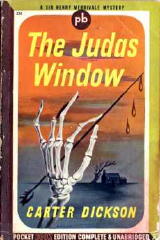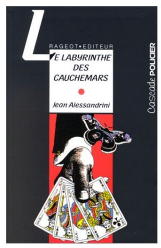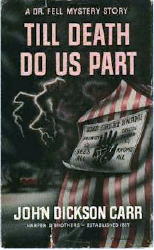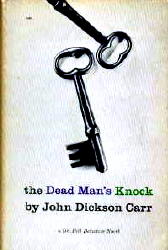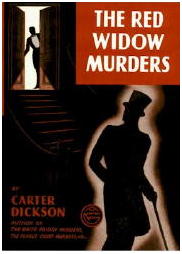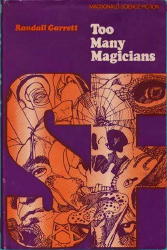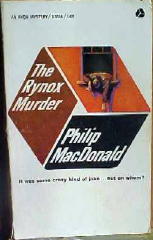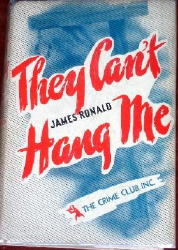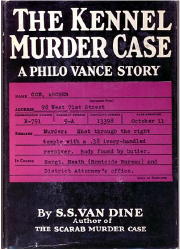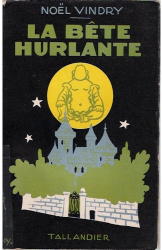|
A Locked Room Library
by John Pugmire In the introduction to his 1981 anthology “All But Impossible,” Ed Hoch invited seventeen well-known authors and reviewers of detective fiction to rank the top impossible crime novels. They were each invited to name their favourite works, up to ten in number, ranked in order of preference. The cumulative results of this now-celebrated exercise are shown in Table 1. Note that, despite the French having been major contributors to the annals of detective fiction, only one novel of French origin appeared on the list (Gaston Leroux’s “The Mystery of the Yellow Room,” named by John Dickson Carr himself as the greatest work in the genre). This was scarcely surprising for – with the exception of Leroux’s work and Pierre Boileau’s “Repos de Bacchus” (see FOOTNOTE 1 below) – almost none had been translated into English. By contrast, a great many English-language works had been, and still are, routinely translated into French, which gives French readers a far wider range of choice than that available to Anglophones. An exercise recently organised in Paris should consequently be of considerable interest to every lover of impossible crimes. In January 2007, the noted French locked room anthologist Roland Lacourbe suggested to his publisher the creation of a list of novels which should be included in any respectable French locked room lover’s collection. The list was to be included as an appendix to an anthology of thirteen seminal novels and short stories selected by him which was, in fact, published in April of this year under the title “Mystères à Huis Clos (Mysteries In Camera)” Omnibus 2007. Monsieur Lacourbe in turn invited a number of known locked room enthusiasts to nominate candidates for this Locked Room Library. There were nine participants in all, including Roland Lacourbe himself. The others were: Robert Adey, editor of the classic bibliography “Locked Room Murders” and a participant in Ed Hoch’s original ranking; the three Belgian amateurs responsible for the French equivalent of the Adey classic, “Chambres Closes, Crimes Impossibles (Locked Rooms, Impossible Crimes)” Livres sur Sambre 1997: Michel Soupart, Philippe Fooz, and Vincent Bourgeois; the co-publisher of “Mystery Scene” magazine, Brian Skupin; a French research student whose thesis was on locked-room literature, Romain Brian; and two translators of the works of Paul Halter, the French writer on whom John Dickson Carr’s mantle is said to have fallen: Igor Longo and myself. Six of the nine were able to read both English and French. The exercise differed from that organised in 1981: in the first place, all the books had to be available in the French language, although not necessarily of French origin; secondly, there was to be no limitation on the number of books nominated; thirdly, no attempt was made to rank the books. The process was very simple: each participant submitted his candidates and the complete list of titles submitted was distributed to all. Participants were asked to vote only on whether an individual work merited inclusion or not (no vetoes were allowed, for reasons which will become evident.) Any book with at least four votes was included. The resultant Locked Room Library shown in Table 2 contains ninety-nine novels. (I have taken the liberty of replacing Carter Dickson’s “The Third Bullet” – a novella – with Gaston Leroux’s “The Mystery of the Yellow Room” which M. Lacourbe had previously declared hors concours.) The striking feature of this list is that about 40% of the titles have never been published in English. I have read a good many of the French-origin books and they are uniformly of a very high quality, so it is not just Gallic pride that has given them a place, more a failure of Anglo-Saxon publishers to recognise the opportunity. Why was no attempt made to rank the works? Well, for a start, those participants who only spoke English could not be expected to be familiar with works which had never been translated; the same applied to the Francophones, but to a far lesser degree. There was the further problem that a book might not have been accurately translated, the most glaring example being Christianna Brand’s “Death of Jezebel” which some believe contains one of the most audaciously brilliant locked room solutions ever published. Unfortunately, the translator clearly hadn’t understood it and included his own utterly stupid and banal solution. Scarce wonder, then, that it received no votes from the the Francophones, and was even subject to a veto attempt! Despite all these obstacles, and a few curious omissions (Ngaio Marsh’s “Off With His Head,” Agatha Christie’s “Why Didn’t They Ask Evans?” and John Dickson Carr’s “The White Priory Murders” to name but three) it is a pretty fair and comprehensive list, particularly if one adds the additional 14 titles gleaning 4 votes but not available in French, which include a couple of superb Japanese mysteries: Akimitsu Takagi’s “The Tattoo Murders” and Soji Shimada’s “The Tokyo Zodiac Murders” both happily available in English. In the full knowledge of how frustrating it is to read about books one has little chance of reading oneself in the near future (I’m still hoping someone will publish some of the treasure trove of great Japanese impossible crime novels I feel sure is out there), I nevertheless feel obliged to offer a few comments on selected books and, in passing, offer some insight on French law enforcement and judicial systems and the resulting influence on French crime literature. Despite Leroux’s early triumph, French writers in general came late to what we call the Golden Age of detective fiction; in fact many wrote parodies about what they perceived as a style with too many rules and set in artificial surroundings. One of them (actually a Belgian), Georges Simenon, declared war on the genre and could be said to be the pioneer of the police procedural or whydunnit? There were far fewer writers attempting impossible mysteries, but those that did stuck to the genre and were more prolific than most of their Anglo-Saxon counterparts. The best-known in the 1930’s were Pierre Boileau and Thomas Narcejac who had each separately been a winner of one of France’s top awards, Le Prix du Roman d’Aventures, before teaming up to write the psychological thrillers for which they became world-famous (the films ‘Vertigo’ and ‘Diabolique’ were adapted from their books.) In the manner of Ellery Queen, Boileau was the Dannay who crafted the artfully-structured plots and Narcejac was the Lee who added the colour, characterisation and atmosphere. Boileau’s “Six Crimes sans Assassin” which translates crudely as “Six Crimes with no Killer” is a masterpiece. A dying woman stands at a window calling for help, but when the police break down her door the apartment is empty except for her and her dead husband; the only other door is bolted from the inside. Later, another body appears in a room which has just been searched and a fourth inside a house with all doors bolted on the inside and all windows barred. A fifth person dies inside a building guarded on all sides by the police. Each time the fiendish killer vanishes without a trace and nobody can discover the method he is using, but all is resolved with impeccable fairness by the time of the sixth and final death. Marcel Lanteaume wrote a number of impossible crime novels, the most celebrated of which was “Trompe l’oeil (Trompe l’oeil)!” At the centre of a billionaire’s house is a dodecagonal room whose walls are mirrors. One of the mirrors can be swung open to reveal a spiral staircase leading up to a room containing a priceless diamond which is kept under constant surveillance by a team of six insurance company detectives from six countries, previously unknown to each other. Every half-hour, one of the six is allowed to leave the room for a short break and return. Despite the extreme measures, and the presence of at least five people at all times, when the surveillance is over the real diamond is found to have been replaced by a false one. How could this possible have happened? The solution, while stretching practicality to the limit, is nevertheless fiendishly ingenious and quite unique. (This is probably as good a place as any to point out that the French are more appreciative of a touch of fantasy in their crime fiction than are the phlegmatic English.) Noel Vindry is unknown outside France yet he wrote thirteen novels, most of which were impossible crimes. He prided himself on his strict adherence to Golden Age rules and was in that sense the antithesis of Simenon, whose work he detested. His detective is Monsieur Allou, an examining magistrate – a feature of the French criminal justice system whereby a single individual is given total authority over a case, from investigating crime scenes to questioning witnesses to ordering the arrest of suspects to preparing the prosecution’s case. Allou is a deliberately dry figure about whom we learn almost nothing; his cases provide all the colourful interest. In “La Maison Qui Tue (The House That Kills)” a remote villa is subject to threats from an unseen gang apparently bent on revenge. Somehow, it appears they gain access and, despite police presence in the house, two people die in impossible circumstances. M.Allou, having solved those cases by the midpoint of the novel, is then himself threatened. He is shot in the head inside his fourth-floor apartment whose door is locked in the inside. Someone standing outside the door hears everything but can see nothing. When the door is broken down, the apartment is empty except for Allou who cannot remember anything. Nobody could have climbed in or out through the window and nobody could have left through the door, yet there is nobody else there. In contrast to Boileau and Vindry, Messrs. Herbert and Wyl were not prolific, but their “La Maison Interdite (The Forbidden House)” is a minor classic. A mysterious stranger who has been threatening the owner of an isolated mansion appears on the threshold one dark and stormy night. The staff, hiding in fear, hear words exchanged, shots ringing out, and the door clanging shut in the face of one of the estate watchmen. Their master is subsequently found dead but his assailant has vanished under their noses. I selected this book because it has without question the finest court-room denouement I have ever read, but one only made possible by the French judicial system. One of the defence witnesses is allowed by the three-judge tribunal (a characteristic of the French system) to build a case which exonerates the accused and reveals a solution which is a total surprise but an inevitable one in hindsight, all while the judges sit passively by and let him talk. It could never happen in the UK or the US. Yet another feature of French detective fiction is how much deference is given by the police to the gifted amateur. In Carr’s work, Fell and Merrivale work with highly competent professionals Hadley and Masters, each quite capable of insightful deduction; the French template is closer to Holmes’ contemptuous treatment of Lestrade. In their Golden Age literature the police are usually ciphers in the background. Rare is the instance of a mid-rank policeman solving a crime in the manner of a French, a Trent or an Alleyn. (Simenon was not Golden Age and having a policeman as the solver of mysteries was another way he distanced himself from the ‘cosies.’ It did not, however, prevent him from writing a very decent locked room short story: “The House in Croix Rousse.”) The absence of the police detective in French literature may well be a reflection of the reduced power of the local police themselves compared to their English and American counterparts. Not only did anyone below the equivalent of Chief Inspector have to defer to the examining magistrate but in the 1930’s they also had to cope with the Brigade Mobile – the equivalent of Scotland Yard’s Flying Squad, but on a national scale – which could swoop down and usurp their powers without warning. Not surprisingly, their morale was terrible and any arrogant amateur could cow them into submission. (Philo Vance would have had a field day and Ellery Queen would have disowned his father.) This contempt for the police is not found in the books of Paul Halter, the most prolific author of impossible crimes in French fiction and the closest rival to John Dickson Carr in the quantity and quality of his output. At the time of writing, he has produced thirty-one novels and fifteen short stories (of which all but a few are impossible crime mysteries). His principle detectives are Dr. Alan Twist, a criminologist who works hand in glove with Inspector Archibald Hurst of the Yard, and Owen Burns, an Edwardian aesthete who finds art in murder and whose police partner has the unlikely name of Inspector Wedekind. One explanation for Halter’s police having more respect is that all his novels take place in England. The February 2005 issue of Mystery*File (also online) covered M. Halter’s work in some detail, so I will not repeat myself here, except to say that his creative brilliance continues unabated. Since that article, a collection of his short stories entitled “The Night of the Wolf” has been published in English by Wildside Press, to critical acclaim, including one story: “The Flower Girl” being nominated for a Barry Award. (FOOTNOTE 2.) Of the ninety-nine novels nominated for the Locked Room Library, thirteen were by Halter, a number exceeded only by Carr/Dickson, yet no publisher has so far stepped forward to offer any of Halter’s novels to the Anglophone market. Surely there is an opportunity here, not just for Halter but for Boileau, Vindry and the others who, between them have contributed 40% of some of the best locked room novels ever written. Whether that happens or not, M Lacourbe will have performed a valuable service, even for those unable to read French: he will, for the first time, have identified the 60 to 70 best locked room mysteries in the English language. FOOTNOTE 1: The full circumstances are not yet known, but in a sense the book “Repos de Bacchus” by Pierre Boileau has appeared in English as “The Sleeping Bacchus,” but attributed to Hilary St.George Saunders. While the latter wrote many other mysteries and thrillers under several pen names, Francis Beeding being the most notable among them, this is the only mystery novel to appear under Saunders’ own name. When I spoke recently to Robert Adey about the Saunders book, he read to me the salient part of his introduction: “I am
indebted to Mr. Boileau for permission to adapt for my purpose certain
scenes and situations depicted in his novel and for permission to use
the title.”
I haven’t read Saunders book, and Bob hasn’t read Bouleau’s, so there’s no side-by-side comparison, but I suspect that Saunders borrowed very extensively from Boileau. Sincere thanks to Steve Lewis, not only for his encouragement but also his hard work formatting, editing and searching out a great many of the covers in the tables that follow. J. P.
Table 1: 1981 Ranking
Participants: Robert Adey, Jack Adrian, Jacques Barzun, Jon L. Breen, Robert E. Briney, Jan Broberg, Frederick Dannay, Douglas G. Greene, Howard Haycraft, Edward D. Hoch, Marvin Lachman, Richard Levinson & William Link (joint list), Francis M. Nevins, Jr., Otto Penzler, Bill Pronzini, Julian Symons, and Donald A. Yates 99 Novels for a Locked Room Library
Notes:
(1) The novels in
bold
garnered at least 7 votes out of 9. (2) Carter Dickson’s “The
Third Bullet” (1937) and
Israel Zangwill’s “The Big Bow Mystery” (1892) are excluded because
they
are novellas. (3) The 14 novels below received at least 4 votes but are not yet available in French:
YOUR COMMENTS ARE WELCOME.
Copyright © 2007 by John Pugmire.
|




